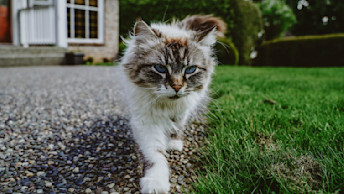May 6, 2024
Can Cats Eat Mushrooms?

Can cats eat mushrooms? This is a question that pops up for many pet owners, especially given our feline friends' natural curiosity. Their explorative behavior may lead them to sample various items around the yard, including mushrooms. Keep in mind, what seems like an innocent nibble to a cat can turn out to be quite dangerous, depending on the type of mushroom.
Can Cats Have Mushrooms from the Grocery Store?
Indeed, your feline friend can enjoy certain edible mushrooms that make their way to your dining plate. Common grocery store mushrooms such as white button mushrooms, portobellos, and shiitake mushrooms are safe for cats4. Besides being non-toxic, these mushrooms are a source of beneficial nutrients like B vitamins and minerals.
Remember that treats and additional food items at mealtime should never exceed 10% of your cat’s daily caloric intake.
When introducing mushrooms, go slowly to monitor your cat's reaction. Make sure mushrooms are thoroughly cooked, as raw mushrooms may be harder for cats to digest.
Can Cats Eat Wild Mushrooms?
Wild mushrooms or toadstools, well-known for their toxicity, are a clear threat to your cat's wellbeing. Several wild mushroom varieties contain potent toxins that, if ingested, can be fatal.
Familiarize yourself with common toxic wild mushrooms and ensure your garden or backyard is free from them. With their smaller bodies, cats are especially vulnerable, meaning even tiny portions can be harmful or even fatal. Therefore, consider all wild mushrooms off-limits.
Common Toxic Wild Mushrooms
Fly Agaric (Amanita Muscaria): Straight out of a storybook scene, the Fly Agaric mushroom sports a vibrant red cap with whimsical white spots. But don't be deceived by its charming looks—this mushroom contains neurotoxins known to poison cats, dogs, and humans1.
Death Cap Mushrooms (Amanita spp.): These mushrooms typically have a pale yellow, green, or white cap with white gills5. All death caps are extremely poisonous, especially for pets2 and should be avoided at all costs.
False Morel (Gyromitra esculenta): False morels can trick you because they look like the edible morels, however they’re considered poisonous. Eating them can cause severe illness or even death7.
Galerina Marginata (Deadly galerina): Deadly galerinas often hide among moss and dead wood. Eating this can cause severe poisoning and are known to kill cats and dogs6, so it's best to stay clear of it.
It's important to remove wild mushrooms from any areas your cat has access to, like your backyard or garden, to prevent accidental ingestion. Keep a close eye on your cat when outside to ensure they don't sample or play with any mushrooms.
Mushroom Poisoning Symptoms
Mushroom poisoning can cause a range of concerning symptoms in cats3,9.
Common signs to watch for include:
- Vomiting
- Diarrhea
- Drooling
- Loss of appetite
- Increased thirst
- Disorientation
- Seizures
If you notice any alarming symptoms, rush your furry friend to the vet immediately. The sooner they get treated, the better their chances of recovery.
Ensuring Mushroom-Free Zones
Preventing cats from encountering toxic mushrooms should indeed be on every pet owner's priority list. Here's some advice to help you on this mission:
Regularly inspect your garden and its surroundings. Be cautious of areas where mushrooms might grow and remove any you find, using gloves.
Use natural mushroom repellents like vinegar or dish soap8.
Restrict access to wild areas on your property. Keep your cats indoors or use netting or fencing to secure risky zones.
Make sure to clear mushroom-friendly habitats like rotting logs and mulch beds off your property.
If your property is prone to severe mushroom growth, you might want to contact a professional exterminator. They can accurately identify the toxic species and safely eliminate them.
Ensuring your curious friends remain free from mushroom-induced harm requires constant vigilance. Make it a routine to prevent mushroom growth, removing any mushrooms you spot immediately, and keep your cats safe from areas where mushrooms might be present.
"Amanita Muscaria." Beaty Biodiversity Museum. Accessed April 3, 2024. https://explore.beatymuseum.ubc.ca/mushroomsup/A_muscaria.html.
"Amanita Phalloides." Beaty Biodiversity Museum. Accessed April 3, 2024. https://explore.beatymuseum.ubc.ca/mushroomsup/A_phalloides.html.
"Can Cats Eat Mushrooms." Pet Poison Helpline. Accessed April 3, 2024. https://www.petpoisonhelpline.com/pet-tips/can-cats-eat-mushrooms/.
"Can Cats Eat Mushrooms." Wag Walking. Accessed April 3, 2024. https://wagwalking.com/wellness/can-cats-eat-mushrooms.
"Death Cap Mushroom (Amanita phalloides) is Poisonous." BC Centre for Disease Control, PDF file. Accessed April 3, 2024. http://www.bccdc.ca/resource-gallery/Documents/Educational%20Materials/EH/FPS/Fruit%20and%20Veg/The%20death%20cap%20mushroom%20%28Amanita%20phalloides%29%20is%20poisonous_3%20fold%20brochure.pdf.
"Galerina Marginata." Beaty Biodiversity Museum. Accessed April 3, 2024. https://explore.beatymuseum.ubc.ca/mushroomsup/G_marginata.html.
"Gyromitra Esculenta." Beaty Biodiversity Museum. Accessed April 3, 2024. https://explore.beatymuseum.ubc.ca/mushroomsup/G_esculenta.html.
"How to Get Rid of Mushrooms." The Spruce. Accessed April 3, 2024. https://www.thespruce.com/how-to-get-rid-of-mushrooms-4706508.
"Not-So-Magic Mushrooms: Tips to Keep Your Pets Safe." ASPCA. Accessed April 3, 2024. https://www.aspca.org/news/not-so-magic-mushrooms-tips-keep-your-pets-safe.



